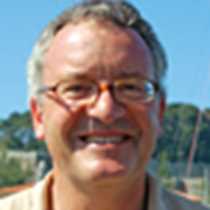At Sea
Yesterday evening in sultry weather and with a residual swell from a recent hurricane, we departed the proud city of Lisbon, built like Rome on seven hills, to sail down the Tagus into the wide open Atlantic Ocean. Passing beneath Europe’s third largest suspension bridge, we again observed the impressive Monument to the Discoverers, a timely reminder of those earlier expeditions that had succeeded in propelling Portugal from provincial obscurity to great power status by the end of the fifteenth century.
Henry the Navigator, whose turbaned bust is at the prow of the monument, was a man with one foot in the mediaeval world and the other in the modern. He founded the first European city on mainland Africa (Ceuta) and promoted a series of expeditions to nose along the west coast of Africa (from his base at Sagres) more from mediaeval motives - than for any goals of scientific exploration. He would achieve knighthood with honor, harry the Infidel as was his Christian duty, maybe even succeed in joining forces with the legendary Prester John. Yet, throughout his lifetime, he would not allow legend or superstition on the part of officers or crew to get in the way of an objective understanding of the coastline of the African continent, a continent that beguiled him as it has so many Europeans ever since. Towards the end of his life in 1453, by which time Portuguese influence had spread rapidly down the west African coast, he grasped the significance of the fall of Constantinople to the Muslim Turks for the future of his country. The consequent decline of the Venetian carrying trade would be Portugal’s opportunity.
The generation after Henry's death in 1394 saw Bartholomew Diaz round the continent naming what he aptly described, for the fortunes of his country, as the Cape of Good Hope in 1467. That hope was fulfilled some twenty years later in 1498 when Vasco da Gama reached Calicut on the Indian sub-continent. By 1500, Cabral, running with the trade winds on the same Atlantic routes inadvertently discovered Brazil. A Portuguese Empire, that Henry the Navigator could not possibly have envisaged, had been born.
The exotic world of the tropics intoxicated the subsequent generation of Portugal’s artists and writers. The national poet Casoes lies with Vasco da Gama in a place of honour inside the Jeronimoes monastery, itself a remarkable survival of the Manueline style after the 1755 earthquake that destroyed so much of the mediaeval city. Its pillars and arcades, as we saw on our morning tour yesterday, are carved with tropical foliage and elephants support the tombs of the royal mausoleum. It is into that tropical world that we are now sailing, in the wake of the Portuguese discoverers whose world we have inherited.
Yesterday evening in sultry weather and with a residual swell from a recent hurricane, we departed the proud city of Lisbon, built like Rome on seven hills, to sail down the Tagus into the wide open Atlantic Ocean. Passing beneath Europe’s third largest suspension bridge, we again observed the impressive Monument to the Discoverers, a timely reminder of those earlier expeditions that had succeeded in propelling Portugal from provincial obscurity to great power status by the end of the fifteenth century.
Henry the Navigator, whose turbaned bust is at the prow of the monument, was a man with one foot in the mediaeval world and the other in the modern. He founded the first European city on mainland Africa (Ceuta) and promoted a series of expeditions to nose along the west coast of Africa (from his base at Sagres) more from mediaeval motives - than for any goals of scientific exploration. He would achieve knighthood with honor, harry the Infidel as was his Christian duty, maybe even succeed in joining forces with the legendary Prester John. Yet, throughout his lifetime, he would not allow legend or superstition on the part of officers or crew to get in the way of an objective understanding of the coastline of the African continent, a continent that beguiled him as it has so many Europeans ever since. Towards the end of his life in 1453, by which time Portuguese influence had spread rapidly down the west African coast, he grasped the significance of the fall of Constantinople to the Muslim Turks for the future of his country. The consequent decline of the Venetian carrying trade would be Portugal’s opportunity.
The generation after Henry's death in 1394 saw Bartholomew Diaz round the continent naming what he aptly described, for the fortunes of his country, as the Cape of Good Hope in 1467. That hope was fulfilled some twenty years later in 1498 when Vasco da Gama reached Calicut on the Indian sub-continent. By 1500, Cabral, running with the trade winds on the same Atlantic routes inadvertently discovered Brazil. A Portuguese Empire, that Henry the Navigator could not possibly have envisaged, had been born.
The exotic world of the tropics intoxicated the subsequent generation of Portugal’s artists and writers. The national poet Casoes lies with Vasco da Gama in a place of honour inside the Jeronimoes monastery, itself a remarkable survival of the Manueline style after the 1755 earthquake that destroyed so much of the mediaeval city. Its pillars and arcades, as we saw on our morning tour yesterday, are carved with tropical foliage and elephants support the tombs of the royal mausoleum. It is into that tropical world that we are now sailing, in the wake of the Portuguese discoverers whose world we have inherited.




